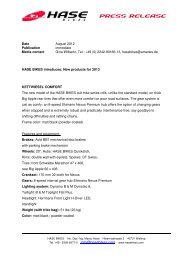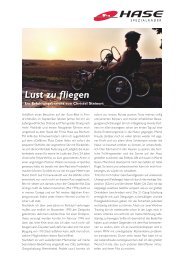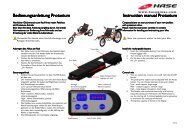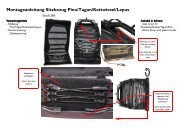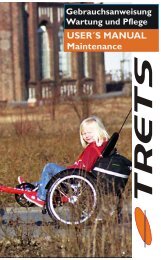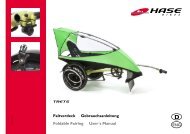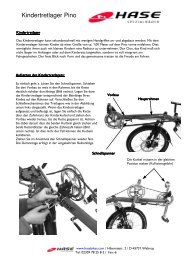Trets Mode d'emploi, version 9-09 F-ENG - Hase Bikes
Trets Mode d'emploi, version 9-09 F-ENG - Hase Bikes
Trets Mode d'emploi, version 9-09 F-ENG - Hase Bikes
Create successful ePaper yourself
Turn your PDF publications into a flip-book with our unique Google optimized e-Paper software.
TRETS<br />
Atteler le <strong>Trets</strong> au vélo tracteur<br />
. Poussez le bouton ( ) de l’embout tournant (2) du timon<br />
puis tournez l’embout dans le sens antihoraire.<br />
2. Connectez l’embout sur la baïonnette qui reste à demeure<br />
sur le vélo.<br />
3. Tournez l’embout du timon dans le sens horaire. Le<br />
verrouillage doit être visible et accompagné d’un déclic<br />
audible.<br />
4. Assurez l’attelage en passant la bride de sécurité autour<br />
du cadre du vélo.<br />
Remarque :<br />
La serrure (3) permet de protéger la remorque contre le<br />
vol. Par précaution supplémentaire, nous recommandons<br />
d‘attacher remorque et vélo à un élément fixe tel que<br />
qu’un arbre, un réverbère etc.<br />
5. Vérifiez ensuite que l‘inclinaison du timon est correcte<br />
(page 8).<br />
Attention !<br />
La roue arrière du vélo tracteur devrait être équipée<br />
d’un garde-boue et d’une bavette efficaces contre les<br />
projections de cailloux ou de tous autres objets pouvant<br />
causer des blessures.<br />
Atteler le <strong>Trets</strong> Trike au vélo<br />
Le <strong>Trets</strong> Trike peut, en plus d‘un usage autonome, être utilisé<br />
attelé. Lors des longues sorties, quand l’enfant qui pédale<br />
en autonomie se fatigue, le <strong>Trets</strong> Trike peut être aisément<br />
transformé en remorque attelée. Il vous faut pour cela un timon<br />
optionnel et une attache Weber fixée au vélo tracteur.<br />
Prise en main et utilisation<br />
Riding your <strong>Trets</strong><br />
<strong>Trets</strong> 9/<strong>09</strong>-F-<strong>ENG</strong> 3<br />
3<br />
2<br />
Hitching the <strong>Trets</strong> to the towing bicycle<br />
. Press the button ( ) on the rotating grip (2) of the drawbar<br />
and turn the grip counterclockwise.<br />
2. Push the drawbar coupling onto the hitch assembly of the<br />
towing bicycle.<br />
3. Turn the drawbar grip clockwise until the locking mechanism<br />
engages. (You will hear a click and see that the button<br />
has returned to the locked position.)<br />
4. Feed the safety strap through the frame of the towing<br />
bicycle and fasten securely.<br />
Note:<br />
You can use the lock (3) to protect the trailer from theft.<br />
To further reduce the risk of theft, we recommend using<br />
additional bicycle locks and locking the trailer with the<br />
towing bicycle to a fixed, immovable object, such as a<br />
tree, lamppost, etc.<br />
5. Now check the adjustment of the drawbar angle (see<br />
page 8).<br />
Caution!<br />
The rear wheel of the towing bicycle must be equipped<br />
with a splash guard. Otherwise, stones or other small<br />
objects thrown from the wheel could injure the trailer<br />
passenger.<br />
Hitching the <strong>Trets</strong> Trike to the towing bicycle<br />
The <strong>Trets</strong> Trike can be used as both a trike and a trailer. For<br />
example, if the family is on a longer trip and the child needs a<br />
break from pedaling, the <strong>Trets</strong> Trike can be quickly converted<br />
to a trailer. For this, you will need a Weber hitch assembly on<br />
the towing bicycle and the optional <strong>Trets</strong> drawbar.





